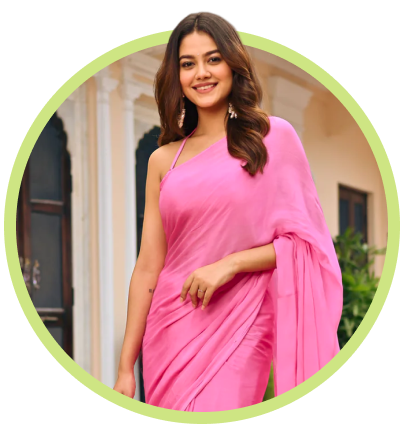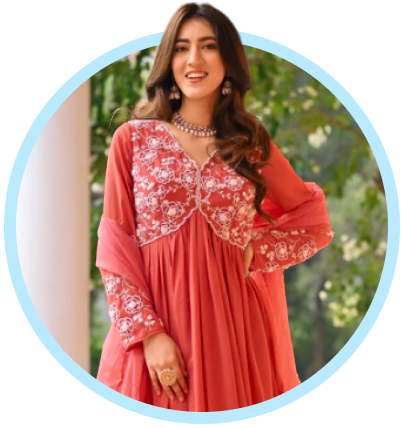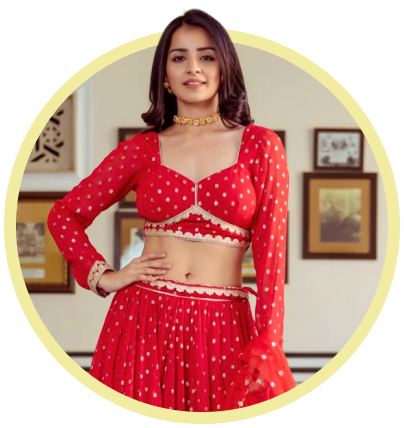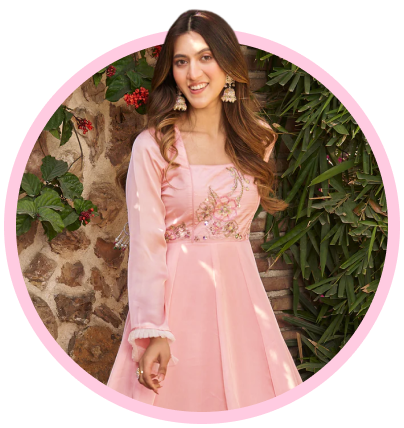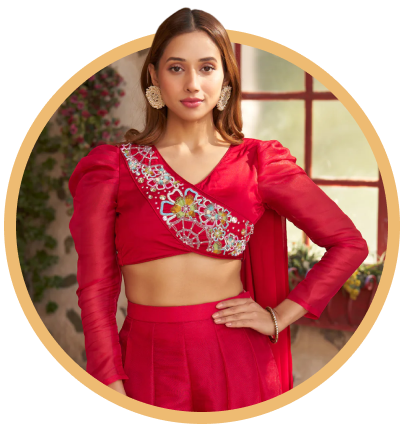
A Brief Overview of the Rich History Behind the Banarasi Silk Saree

Although some historians relate Banarasi silk to the described clothing of gods in many Puranas, this type of saree came into existence or instead received a boost in popularity during the reign of the Mughal emperor Akbar. Such was his fondness for the fabric that he did not limit its use to clothing and adorned his palace with Banarasi silk, be it carpets or curtains. His love for the silk inspired many Muslim weavers to start weaving in Banaras after finding the city suitable for their weaving culture. Therefore, most of the motifs in a Banarasi saree can be found to be Mughal inspired. Intricate intertwining floral and foliate motifs, kalga and bel, a string of leaves called the jhallar on the border is a characteristic of Banarasi sarees, making them stand out among the crowd of sarees.
The Weave Process Behind the Banarasi Silk Saree - How is it Made?
The exquisitely woven Banarasi silk saree exemplifies the elaborate weaving process and the intricate craftsmanship of India's artistry. The rich, traditional garment is best known for its luxurious feel and detailed patterns. The weaving process of the original Banarasi saree is unique and begins with sourcing high-quality silk. Artisans use traditional handlooms to weave motifs that are typically inspired by Mughal and Indian heritage, incorporating fine gold or silver zari threads for a rich, ornate look. The saree is finally removed from the loom and sent for washing and finishing. Further, every piece is dried and ironed, and any remaining loose threads are trimmed to add the final layers of finesse to the masterpiece. Finally, each banarasi saree is carefully packed for sale.
A vibrant Banarasi Patola Silk Saree or the delicate Banarasi Tissue Silk Saree - regardless of which one you pick, each one of them requires months of effort. The painstaking hours invested behind every saree result in a single piece of art.
The weaving process of Banarasi silk saree is an act of love and respect, and a deep appreciation of the traditional art requiring patience and skills of artisans. The saree itself stands as a testament to the rich cultural heritage of India.
The timeless appeal of the Banarasi silk saree has remained the same; however, the garment has embraced the contemporary touch to best suit the fashion sense of the current generation. They are styled with a modern twist, like pairing a Banarasi silk saree with a sleeveless blouse to stay attuned to the changing fashion trends.
Identifying the Authenticity of a Banarasi Saree
The rising demand for gorgeous Banarasi sarees has only resulted in counterfeit versions that are flooding the market today. The quintessential attire has many copies with intricate designs identical to the ones commonly found woven on an original Banarasi silk saree. The saree is unique when it comes to the fabric, designs, and finish; therefore, prices are comparatively higher than readymade sarees. However, counterfeit items can ruin your experience of the gorgeous garment if you fail to identify the original piece and yet pay the same price. So, how to identify a Banarasi silk saree that is authentic?
The history of the Banarasi silk saree suggests that every work on the garment is meticulously done by skilled artisans, where the heavy and intricate thread works are visible on the reverse side of the fabric. However, even this can be deceptively replicated by skilled counterfeiters.
In order to verify the authenticity of the garment, always look for the Geographical Indication (GI) tag, a hallmark that protects both artisans and buyers while certifying the saree’s origin. Additionally, when you explore simple Banarasi saree designs or settle for luxurious Banarasi Patola Silk Sarees, the first thing that you should do is pay close attention to the zari work. Here's a pro tip for you: authentic pieces use pure gold or silver threads, which are heavy and finely detailed. Other features to consider are undoutedly the premium quality silk used and the meticulous weaving process - they define the uniqueness of an original Banarasi saree. Counterfeiters will never be able to replicate the complex artwork, regardless of how skilled they are.
For fashion-forward choices like pairing a Banarasi saree with a sleeveless blouse or selecting a Banarasi Cotton Silk Saree for versatility, knowing how to identify an authentic piece ensures you get timeless elegance and true craftsmanship.
What are the Different Types of Banarasi Silk Saree
A common misconception but let us clear it for you: Banarasi is not just a silk saree. It comes in four different fabric variants with the differing design process. Here is how they are categorized:1. Fabric Variants:
Here are the different fabric variants used to make sarees.● Pure Silk (Katan):

● Shattir:
Shattir is the most abundant type of material used for Banarasi sarees. This is the sole fabric used to create exclusive and contemporary Banarasi saree designs under the name Banarasi.● Organza or Kora with Silk and Zari:
You know them as intricately and richly woven Brocades, where the weft and warp pattern different patterns and designs. In this type of Banarasi Saree, gold-coated silver threads are woven around silk yarn to create the Zari Brocade.● Georgette Banarasi Saree:
A popular choice for contemporary Banarasi, Georgette is a finely woven light fabric with plain and simple weave.2. Design Process
Here are the different Design Process used to make sarees.● Jangla:
Believed to be the oldest of the Banaras brocades, Jangla sarees are woven in colorful silk threads. They get their name from the design patterns that distinguish from other types of Banarasi sarees- intricate Jangla vegetation motifs across the length of the saree. With unique designs and extreme detailing, this luxurious fabric is perfect for bridal Banarasi saree.● Tanchoi:
Tanchoi, with its beautiful Jamawar style paisley woven pallus, is another excellent choice for wedding Banarasi sarees. Artisans create this type with colorful weft silk yarns, often adorning it with Zari paisleys or labyrinths with criss-cross patterns.● CutWork:
These are the less expensive versions of the above types and Jamdani silk sarees. Artisans mix cotton and silk and use cutwork technique on a plain textured fabric. Some of the popular motifs for cutwork Banarasi saree are jasmine, marigold flowers, creepers, and leaves.● Tissue:

Tissue Banarasi sarees have the most delicate look of them all. These delicately woven sarees have golden zari weft, adding a sheen to the saree. One of the popular designs in this type includes beautiful zari lotus and cutwork water droplets with self-woven paisleys on the borders.
● Butidar:
Butidar sarees are the most popular and distinctive type of lot. They are woven with a combination of silver, gold, and silk threads, where gold is darker in the shade than silver. Due to this, this variety of brocade is referred to as Ganga-Jamuna by Banarasi weavers.Identifying The Perfect Blouse for Your Banarasi Saree
Banarasi is the new guinea pig to all fashionista’s crazy fashion experiments. As such, when it comes to finding a blouse for your saree, it can be a tough choice. Here are some blouse patterns you can check out:● Embroidered Blouse:
These bring out the grandeur of your wedding Banarasi saree and the overall bridal look. Embroidered blouses come in a variety of patterns, ranging from extensive stonework on the sleeves and neckline to traditional motifs and artwork on the sleeves.● Simple Sleeveless Blouse:
From Shilpa Shetty Kundra to Shanvi Shrivastava, celebrities have rocked their traditional Banarasi Sarees with the unconventional sleeveless blouses. Whether you are matching your red Banarasi saree or going for a contrast color, you can never go wrong with a simple sleeveless blouse. To get the look right, it is always to for plain material over designs.● Full Sleeve Plain Blouse:
The charm of a full-sleeved blouse never goes away. However, with a banarasi, especially in plain fabrics, the magic of these blouses are evident in the subtle class and regality the whole look exudes. Pair it with a kundan set and a low bun with flowers and you are all set to walk the red carpet with style. Not to mention, winter weddings!● Blouse in Contrasting or Lighter Shade:
If you prefer mix-and-match fashion, then go for a blouse that is either a lighter or completely different shade than your saree. A good example would be wearing a royal blue Banarasi with floral motifs with a bright pink blouse. Alternatively, you can wear that forest green saree with a blouse in sage green. However, make sure you choose a color that compliments your saree color.● Elbow Length Blouse with Matching Borders:
Matching your sleeve border with your saree fall is one of the most popular blouse fashions, regardless of the type of saree. However, with a Banarasi, this look is one that can always be found in the vogue. The sleeve length of this blouse need not necessarily reach upto the elbow, you can always opt for bicep length and still rock this look.● Brocade Blouse:
Brocade blouses are perfect for the subtle party look with the simplicity and dainty vibes they give off, especially when paired with the exquisitely embroidered Banarasi. Whether you wearing a matching one or mix it up with contrasting shades, brocade blouses are a sure way to increase your style-o-meter.How to Care for your Banarasi Saree
A gorgeous Banarasi saree is a timeless treasure, but requires careful handling of the garment to retain its original beauty and glamour. Proper maintenance can only ensure that your original Banarasi saree remains as stunning as the day you bought it. Follow these tips to preserve your traditional Banarasi saree for years:
- Avoid Long-Term Hanging
Leaving your saree hanging on a hanger for extended periods can cause permanent creases. Fold it neatly to retain its elegance.
- Store in Muslin Cloth
Wrapping your Banarasi Cotton Silk Saree or Banarasi Tissue Silk Saree in muslin cloth protects it from moisture while allowing proper air circulation.
- Keep in a Dark Corner
Store your saree in a cool, dark spot to prevent discolouration. The muslin cloth wrap gives an extra layer of protection to the garment.
- Low Heat or Steam Ironing
Always use low heat settings for ironing. The best option is to go for steam ironing to prevent damage to the delicate piece. Sometimes, delicate sarees like the Banarasi Silk require professional ironing.
- Avoid Water and Perfume
Water and perfume can stain your saree quickly. Always avoid sprinkling water when ironing, and keep your saree away from liquids.
Buying Banarasi Saree Online
Finding an original Banarasi saree online is a tough task. One can easily be deceived. However, with the right store, this is something you do not have to worry about. Kreeva, with its experienced and talented craftsmen and extensive collection, is one of the best sellers of Banarasi silk saree online. The sheer variety of designs available in different materials like cotton will have you confused over choosing one.Bottom Line
That just about sums up everything you need to know about a Banarasi saree before your next shopping spree. From its origin to its extensively embroidered motifs, the silk saree screams royalty at just one glance. It comes with no surprise, therefore, the amount of popularity a Banarasi has been enjoying for centuries. When cared for in the right way and paired with the perfect blouse and accessories, an original Banarasi will make you look like the queen you are on some of the most important occasions in your life. So, are you ready to rock your Banarasi saree look?
FAQs
What is the history of Banarasi saree?
The Banarasi silk saree history dates back to the Mughal era, known for its intricate designs and Persian influences, making it a timeless traditional attire.
What is special in Banarasi saree?
An original Banarasi saree is renowned for its luxurious silk, fine zari work, and ornate patterns, representing Indian heritage and craftsmanship.
What is the significance of Banarasi silk?
Banarasi silk sarees symbolise elegance and cultural pride, often worn for weddings and festivals, reflecting India’s rich weaving tradition.
Which place is famous for Banarasi silk cotton sarees?
Varanasi is famous for Banarasi Cotton Silk Sarees, blending the softness of cotton with the grandeur of silk for a versatile and gorgeous look.
Which type of silk saree is most expensive?
Banarasi patola silk sarees and Banarasi tissue silk sarees are among the most expensive due to their intricate craftsmanship and premium materials.

